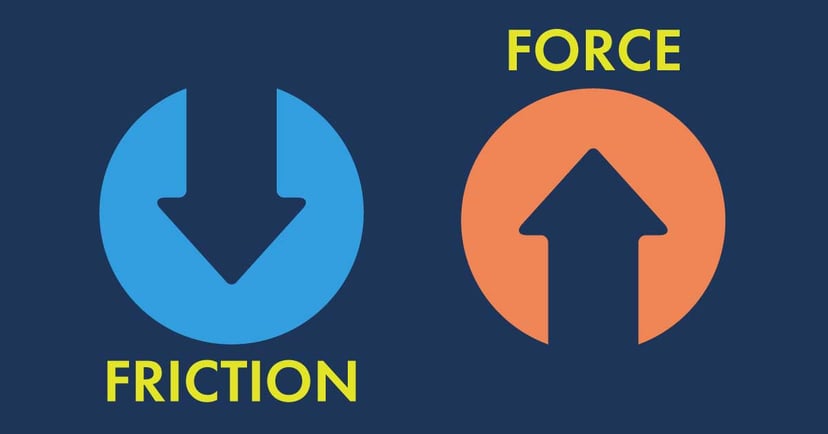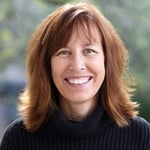Force, Friction, and Flywheel Marketing: Key Ways to Gain Momentum
Written by
 A lot has been made about the shift from funnel to flywheel marketing and how it’s made inbound growth strategies even more powerful. In a nutshell, the inbound flywheel focuses on how customers and prospects experience your company by analyzing interactions at key stages of the buyer journey — attract, engage, delight. It also reveals how your sales, marketing, and service teams influence satisfaction and engagement within those touchpoints.
A lot has been made about the shift from funnel to flywheel marketing and how it’s made inbound growth strategies even more powerful. In a nutshell, the inbound flywheel focuses on how customers and prospects experience your company by analyzing interactions at key stages of the buyer journey — attract, engage, delight. It also reveals how your sales, marketing, and service teams influence satisfaction and engagement within those touchpoints.

Analyzing your flywheel is not gathering data for data’s sake. The flywheel, inbound, and the collective results therefrom can actually save your company money. Why? It costs 5x more to secure a new customer than to retain and fully engage a current customer. Some quick math reinforces why it’s so important to get — and keep — your flywheel spinning.
Identifying Flywheel Forces and Friction
The premise of the flywheel is that how you manage force and friction — the energy sources behind your flywheel — will help or hinder momentum. Which in turn affects your business growth. Force provides positive energy that fuels forward movement and growth. Friction depletes energy and causes the flywheel to stagnate.
Naturally, building force and eliminating friction is the formula for flywheel marketing success, but it can be difficult to concretely identify these points for your own business. Familiarizing yourself with some common causes of force and friction can help.
Common causes of force:
- Customer success stories gleaned from automated VOC programs and shared across your service, sales, and marketing departments
- Positive customer feedback that is gathered, organized, and utilized by your marketing department
- Smart content that’s based on what’s known about the contact and versioned/tested to optimize landing pages and forms
Common causes of friction:
- Low MQL-to-SQL conversion rates caused by a lack of nurturing smart content, workflows, and emails that speak to a lead’s industry, role, or need
- Slow or unresponsive customer service causing customer churn and negative reviews
- Poor lead qualification usually means lead rejection by your sales department — and a waste of time and resources that would add value elsewhere
Practical Application: Attract, Engage, Delight
Understanding force and friction and how they impact flywheel energy is valuable — but how does it fit in an inbound marketing strategy?
Let’s use some practical examples to illustrate how flywheel marketing knowledge aligns with the inbound stages, and the tools that support your efforts. Below is a list of examples in each stage of the flywheel to get your wheels spinning (pun intended). Where applicable, we’ve also listed automation tools in HubSpot that can help make the solution efficient and scalable.
Examples of Force & Friction in the Attract Stage
- Force: Content that helps prospects and customers learn about your products or services, supported by:
- The HubSpot SEO Tool to map out content on your site to attract your buyers at every stage of their journey
- HubSpot Social tools to schedule your posts, monitor the responses, and analyze how well your social posts are attracting potential customers
- Friction: You’re attracting traffic, but it’s not lead-quality traffic. Retool by using:
- HubSpot’s Buyer Persona tool helps you better understand, build, and target your ideal personas
- SEO optimization through a topic cluster approach to your content
Examples of Force & Friction in the Engage Stage
- Force: Based on what you know about the lead, provide content that’s relevant to their situation and moves them further along the buyer path. Consider:
- Inline CTAs in blogs to provide easily accessible content about products and services
- Smart CTA graphics that align with the contact’s lifecycle stage — a subscriber may see a button for an ebook about the “Basics of Design for Manufacturability” while an SQL may see a “Check Out This Case Study” button
- Friction: Low Conversion Rate of Marketing Qualified Leads (MQLs) to Sales Qualified Leads (SQLs). Get the right information to MQLs at the right time in order to move them along the buying path by:
- Leveraging HubSpot workflow automation and smart content in emails to continue to offer relevant content
- Using follow-up emails that automatically invite leads to take the next related step each time they convert (i.e. learn more, view a demo, book a meeting)
- Friction: Poor lead qualification by Marketing and subsequent rejection by your Sales department can be mitigated by collecting better data through:
- Updated forms with progressive fields, meaning if the contact filling out your form already has a value for a specific field, another form field displays in its place
- Leveraging smart rules on emails, landing pages, or website pages based on country, device type, referral source, preferred language, contact list membership, or contact lifecycle stage
Examples of Force & Friction in the Delight Stage
- Force: Positive customer feedback and success stories, gathered and shared through:
- Customer Satisfaction (CSAT) surveys to find out what your customers think of a specific aspect of/interaction with your company
- Net Promoter Score (NPS) to evaluate the overall strength of your company in the eyes of your customers
- Customer Effort Score (CES) to identify how well your customer support or service teams are meeting the needs of your customers
- Friction: Slow response times to customer service can be rectified with:
- An automated system for support tickets (i.e., HubSpot’s Tickets service) so the jobs are assigned to and addressed by the right person from the start
- Unified messaging inbox like HubSpot Conversations that allows your team to chat with customers across a variety of channels, including Facebook Messenger
- HubSpot Knowledge Base to empower customers to search for answers on their own
In order to fully leverage the power of the flywheel, it’s essential to manage the force and friction that exists within your customer experience — starting from their first interaction with your company. After all, customers are the hub of the flywheel, and all interactions ultimately revolve around them.
For a deeper dive into using the inbound flywheel to improve your business, check out our Flywheel Overview & Workbook: Weidert Group's Guide to Growing Your Business With Inbound.
Subscribe To Our Blog
Information. Insights. Ideas. Get notified every time a new Weidert Group blog article is published – subscribe now!
You May Also Like...

Artificial Intelligence
Revenue-Driving B2B Content Marketing Strategy with Andy Crestodina

Artificial Intelligence
AI Agents Are Here—How Smart Businesses Are Using Them Now

Inbound Marketing
Podcasting Playbook: What We Learned After 100 Days of Running a B2B Podcast
Accelerate Your Growth with
Weidert Group
If you’re ready to explore a partnership, request a personalized consultation with our team.
